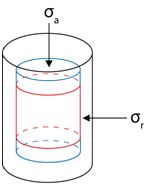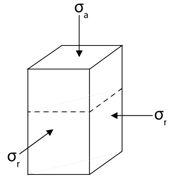Original Cam-Clay model
The original Cam-clay model (OCC) was developed by Andrew Schofield in the 1960s as a description of the behaviour of saturated soil and sands. It shows how, depending on water content, soils can fail by spalling or by plasticity and liquefaction.


Consider a cylinder of water-saturated sand in a triaxial testing regime as in the above figure.
The cylinder is subjected to the total axial stress, σa, and total radial stress, σr. It is more useful to work in terms of the effective stress which takes pore water pressure, u, into account.
\[\sigma ' = \sigma - u (1)\]
This allows us to define the general mean effective compressive stress as \( p' = \frac{1}{3}(\sigma_{1}' + \sigma_{2}' + \sigma_{3}') \). In this case σa = σ1 and σr = σ2 = σ3 and so \[ p' = \frac{1}{3}(\sigma_{a}' + 2\sigma_{r}') (2)\]
A deviator stress, q, can also be defined, given by the equation
\[q = {\sigma_{a}'} - {\sigma_{r}'} (3)\]
In triaxial yield testing it is found that sands and soils on the ‘wet’ side of the critical state yield on a ductile-plastic continuum. The plastic deformations arise as a change in the specific volume of the sample and a strain along its length. We can therefore define the following two strains:
Axial strain: \[\delta {\varepsilon _a} = \frac{{\delta l}}{l} (4)\]
Volumetric strain:\[\frac{{\delta v}}{v} = {\varepsilon _v} = \delta {\varepsilon _a} + 2\delta {\varepsilon _r} (5)\]
To find the triaxial shear strain, εs, we separate the axial and volumetric strains:
\[\begin{aligned} \delta {\varepsilon _s} = \delta {\varepsilon _a} - \frac{1}{3}\delta {\varepsilon _v} \\ = \frac{2}{3}{\delta {\varepsilon _a} - \delta {\varepsilon _r}} \end{aligned} (6)\]
The work done per unit volume by elastic straining is
\[\begin{aligned} \delta W & = p'\delta {\varepsilon _v} + p\delta {\varepsilon _s}\\ & = \frac{1}{3}{\sigma _{a}' + 2\sigma _{r}'} {\delta {\varepsilon _a} + 2\delta {\varepsilon _r}} + \frac{2}{3} {\sigma _{a}' - \sigma _{r}'} {\delta {\varepsilon _a} - \delta {\varepsilon _r}}\\ & = \sigma _{a}'\delta {\varepsilon _a} + \sigma _{r}'2\delta {\varepsilon _r} \end{aligned} (7)\]
For work done by plastic straining at failure for soils at the critical state or wetter than the critical state, the relevant dissipation function is defined by the equation
\[p'\delta {\varepsilon _v} + q\delta {\varepsilon _s} = \delta W = Mp'\delta {\varepsilon _s} (8)\]
where Μ is the general coefficient of friction. The work done against friction per unit volume is defined by this equation. The work done in producing a volume change does not explicitly appear in this model because it is a consequence of the interlocking of particles.
In OCC the associated plastic flow vector is locally orthogonal to the tangent of the yield locus so that
\[dp'\delta {\varepsilon _v} + dq\delta {\varepsilon _s} \ge 0 (9)\]
In words, this equation is a recognition that the scalar product of the plastic flow normal to the yield locus at (p', q) and the incremental loads (dp', dq) causing failure at (p', q) must be positive.
To derive the OCC we combine Equations (8) and (9). First we divide equation (8) by p’δεs :
\[\frac{{\delta {\varepsilon _v}}}{{\delta {\varepsilon _s}}} + \frac{q}{{p'}} = M\]
Rearranging Equation (9) after setting the inequality to zero, we have:
\[\frac{{\delta {\varepsilon _v}}}{{\delta {\varepsilon _s}}} = - \frac{{dq}}{{dp'}}\]
so that eliminating δεv/δεs in these two equations, we produce the equation
\[\frac{q}{{p'}} - \frac{{dq}}{{dp'}} = M (10) \]
This is a differential equation on which we impose limits and introduce the stress ratio, η = q/p’. Differentiating η:
\[\frac{{d\eta }}{{dp}} = \frac{1}{{p'}}\left( {\frac{{dq}}{{dp'}} - \frac{q}{{p'}}} \right) = - \frac{M}{{p'}}\]
\[ ⇒ \frac{d\eta}{M} + \frac{dp'}{p'} = 0 (11) \]
As we are finding the locus for ‘wetter than critical’ states the integral is as follows:
\[ \begin{aligned}
\int_{M}^{\eta} \frac{1}{M}\,d\eta &=-\int_{p'_c}^{p'}\frac{1}{p'}\,dp' \\
\frac{\eta}{M}-1&=-ln\left(\frac{p'}{p'_c}\right) \\
\frac{q}{Mp'} =& 1 - ln\left(\frac{p'}{p'_c}\right)
\end{aligned} \]
Therefore, when p' is equal to p'c, η= M. Also, when q = 0, so that the soil cannot withstand any shear stress at failure, p' = e p'c ,where e is the base of the natural logarithm, 2.71828 … .
In practice q = 0 is actually a situation difficult to attain – see A. Schofield, Disturbed Soil Properties and Geotechnical Design, Thomas Telford Ltd., London, 2005, p. 106.

